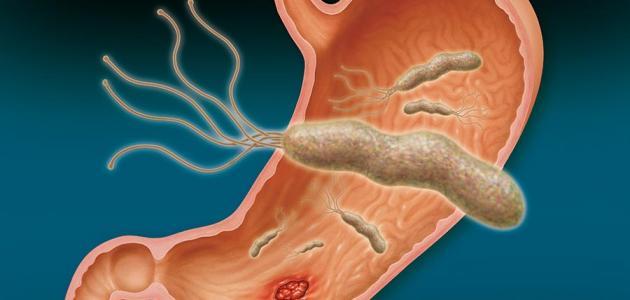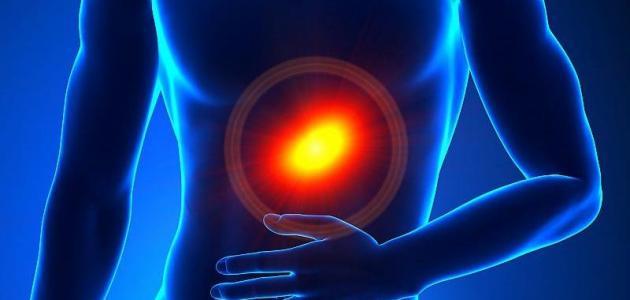Germ stomach
The stomach germ, or what is known as Helicobacter pylori, is an invasive spiral-shaped germ that infiltrates into the stomach and settles in the epithelial cells of the gastric mucosa, over time, causing inflammation and destruction of cells. Which are found in the lining of the stomach or the upper parts of the small intestine, and in some cases can cause stomach cancer. This germ is very common and widespread. As the global infection rate is approximately 50%.
This germ is considered one of the most causes that lead to the emergence of stomach ulcers along with other factors, and this was discovered in 1982 AD by Australian scientists Robin Warren and Perry Marshall, and they deserved the Nobel Prize for their discovery that the cause of most cases of ulcers and gastritis is due to infection with Helicobacter bacteria pylori or stomach germ. Gastroenteritis may also lead to a deficiency in the absorption of important nutrients, such as folic acid and vitamin B12.
Etiology
The reasons that lead to the spread and infection of a person with stomach germs are not completely known, but the germ is often transmitted to humans through saliva, as it is easy to transmit infection between members of the same family if one of its members is infected with stomach germs, or through feces, especially in children. Attention should be paid to washing hands after using public toilets, and paying attention to personal hygiene in general. People can become infected with stomach germs through contaminated water or food.
Read also:Hernia classificationThe most susceptible people
In general, children are the most susceptible to stomach germs. This is because they eat food from whatever source it is, and because they lack knowledge of the reason for the importance of washing their hands after using the toilets. The environment surrounding a person is also important, contributing to infection with stomach germs. The following reasons increase the chances of stomach germs:
- Individuals in developing countries are more likely to be infected with stomach germs than individuals in developed countries. This is due to methods of purification and general hygiene.
- Sharing personal items with people who have stomach germs.
- Living in densely populated places or lacking clean water supplies.
Symptoms
Usually, most people infected with stomach germs do not have any symptoms. When a person has a stomach ulcer or gastritis, he may suffer from one of the following symptoms:
- Frequent belching.
- bloating;
- Nausea.
- Feeling pain and discomfort in the upper abdomen, especially when it is empty at night, or after eating meals.
- Feeling full after eating small amounts of food.
For some people, these symptoms disappear, but for others, they may develop and become more severe in severity, and be an indication of a real problem that requires a doctor's review. Because the following symptoms may indicate the presence of severe infections in the stomach and duodenum:
Read also:What is the treatment for gastroenteritis- The feeling of a stomach germ patient with severe acidity and heartburn in the throat or esophagus.
- Nausea and vomiting are more severe, with the possibility of vomiting accompanied by blood.
- dark stools that look like tar; due to bleeding from ulcers.
- Fatigue.
- Unexplained weight loss.
- Anemia; For several reasons, including chronic bleeding, or iron deficiency.
- Anorexia.
- Bad breath.
- diarrhea.
- Hair loss, cracked and broken nails due to lack of nutrients.
- May increase the chance of stomach cancer.
The diagnosis
In addition to taking correct and accurate pathological information, clinical examination, and knowledge of the medications that the patient is taking; Because there are some medications that lead to symptoms similar to those caused by stomach germs, the doctor can request the following tests in order to confirm his diagnosis, and among these tests are the following:
- Breath testIt is one of the most accurate tests that the doctor resorts to to verify that the patient is infected with stomach germs. The examination is carried out by giving the patient a capsule containing urea, nitrogen, and a small percentage of radioactive carbon. Then, minutes later, the patient is fed a bag attached to a special device. The patient blows into this bag. Because the germ secretes an enzyme that breaks down urea into ammonia and carbon dioxide, which contains radioactive carbon.
- blood testA blood test helps detect the presence of antibodies to the stomach germ in the blood, and because these antibodies remain in the blood even after the germ is eliminated, this test is not considered reliable and credible enough, and therefore it cannot be sufficient to prove the presence of the germ in the body.
- stool testIt is considered a very accurate test, and it detects whether the patient's body contains antigens for the stomach germ.
- Gastroscopy examination: During which a small and flexible tube connected to an optical fiber is inserted into the stomach, and a sample of the mucous membrane of the stomach is taken for examination and detection of the presence of stomach germs, and an examination of the gastrointestinal tract to detect the presence of ulcers or anything abnormal in the gastrointestinal tract.
Diseases caused by stomach germs
In the event that the stomach germ is present in the body of the affected person, it can be a cause of many diseases if the doctor is not reviewed as soon as possible, and some diseases:
Read also:What is the treatment for stomachache- Gastritis.
- ectoderm.
- Indigestion, and digestive problems, such as bowel obstruction, or stomach perforation at the ulcer site.
- stomach cancer.
- Esophageal reflux, and increased risk of esophageal cancer.
- Rosacea, or Rosacea, is a skin disease that causes redness of the face as a result of dilated capillaries.
protection
There is no vaccine against this germ yet, in addition to the way it is transmitted is not fully understood, but there are some preventive methods that can protect against infection with stomach germs, including:
- Wash hands after using the toilet and before eating.
- Do not use or drink unclean water.
- Cook food well, and wash fruits and vegetables before eating them.
treatment
Two antibiotics are often prescribed together for people with stomach germs. To prevent bacterial resistance to one of the two antibiotics, proton pump inhibitors can be prescribed, which in turn reduce the acidity of the stomach. To help the stomach lining heal, and to help antibiotics work better. A bacteriological examination must be conducted four weeks after the start of taking the drug in order for the doctor to see the effectiveness of the drug, and if it is not effective, he may try another type.
Examples of antibiotics that can be used are clarithromycin and amoxicillin. As for proton pump inhibitors, pantoprazole or esomeprazole can be used. The appropriate medication is prescribed based on if the patient suffers from an allergy to a particular drug, or if the patient has another specific pathological condition, then the medication is avoided if it conflicts with the nature of the other problem that the patient has.









